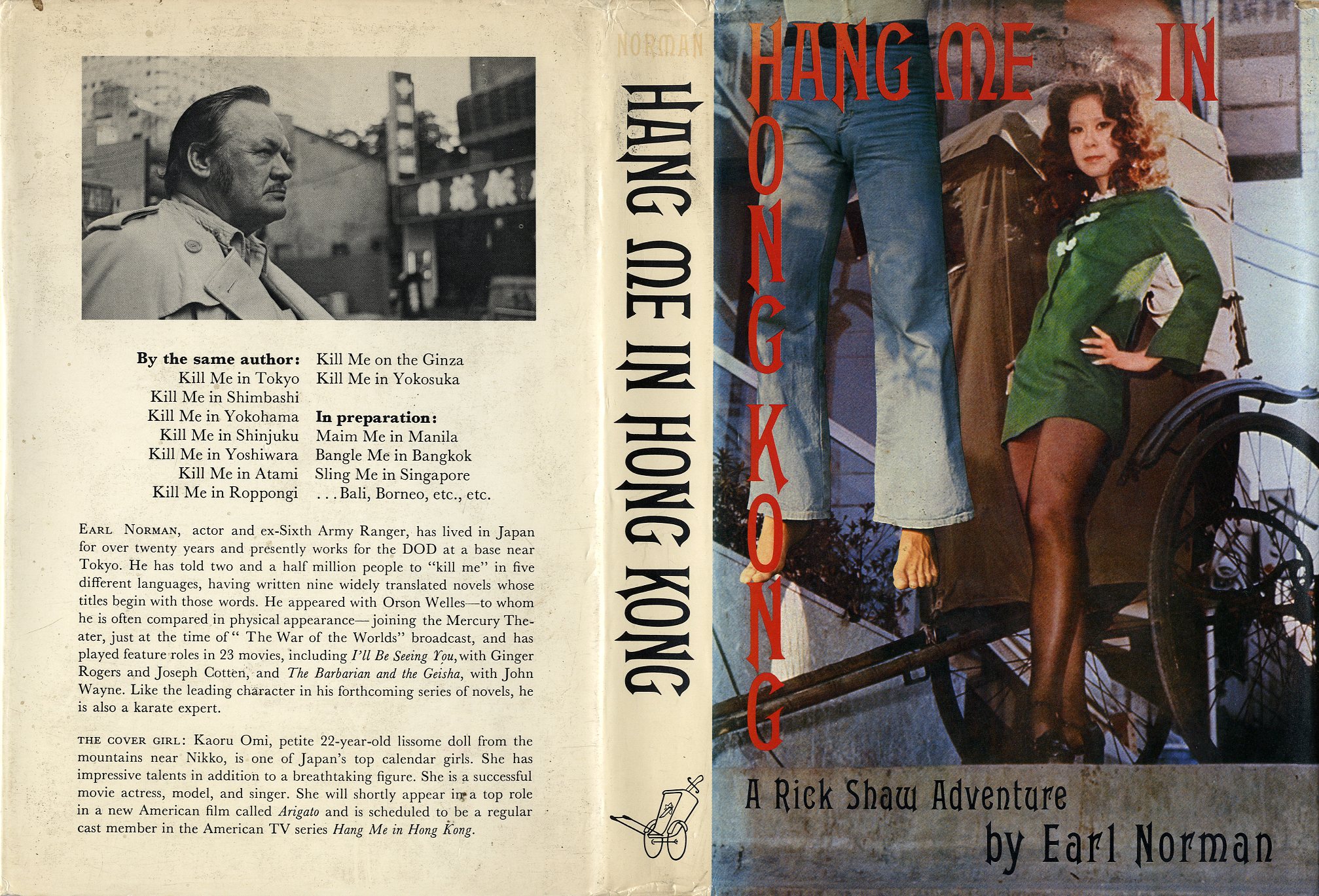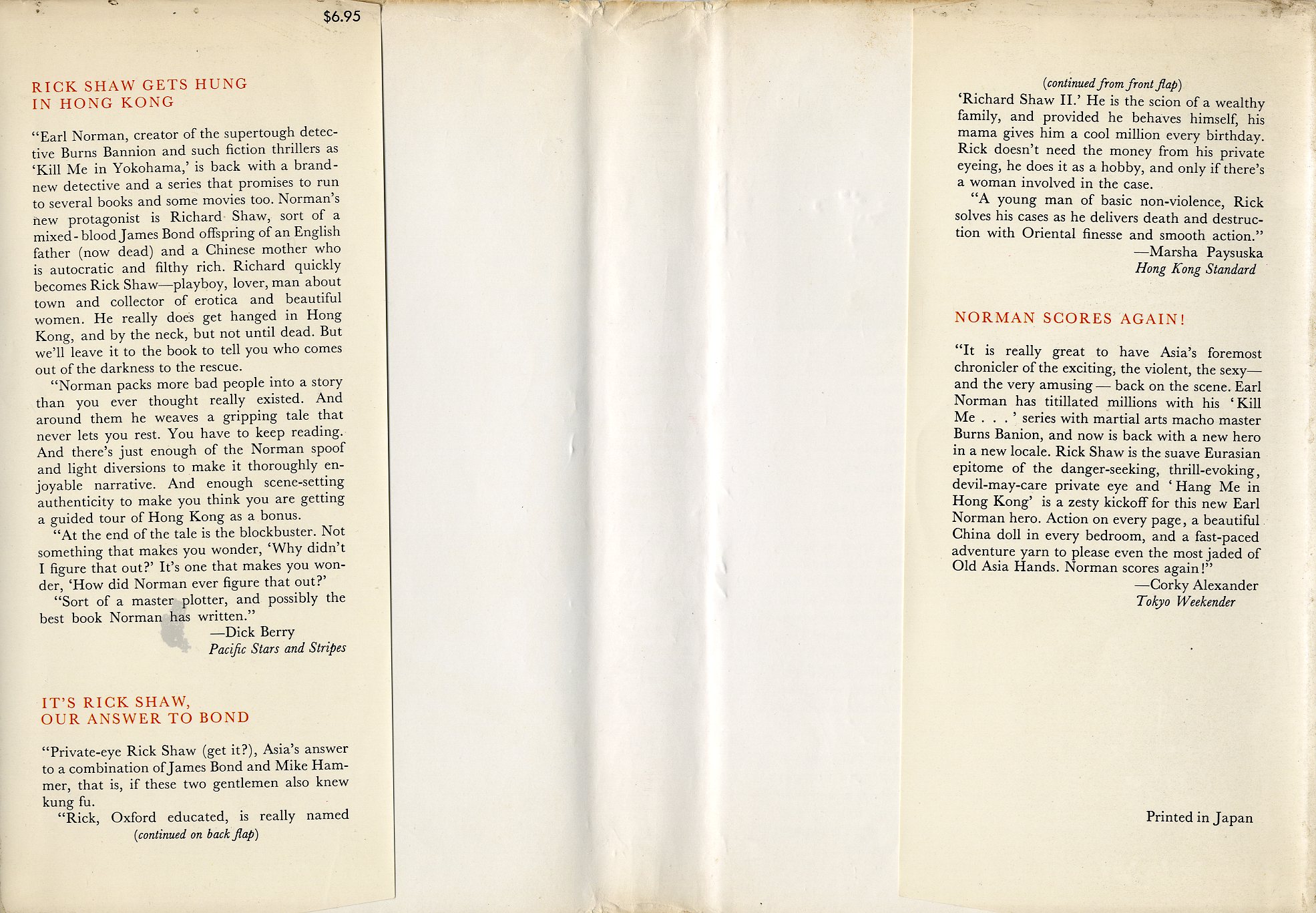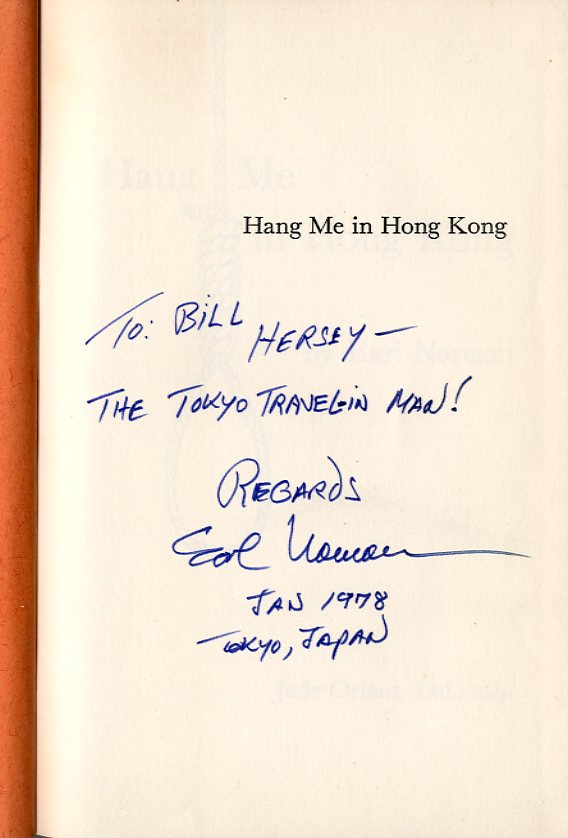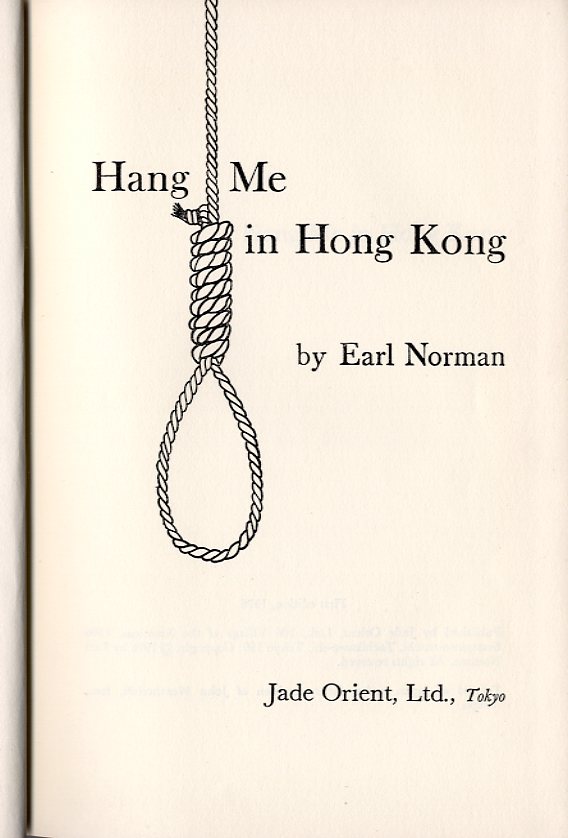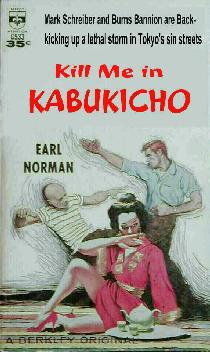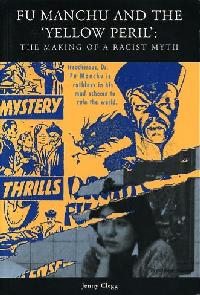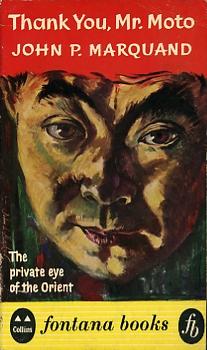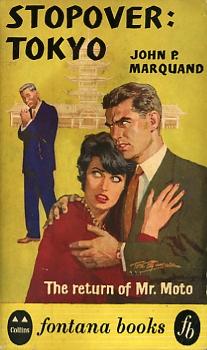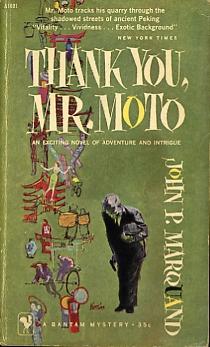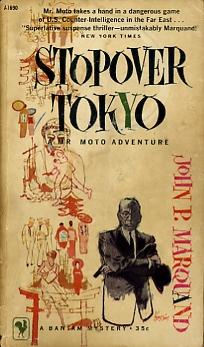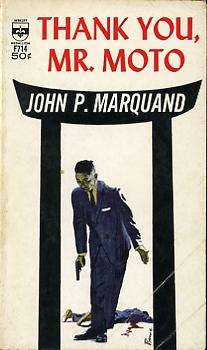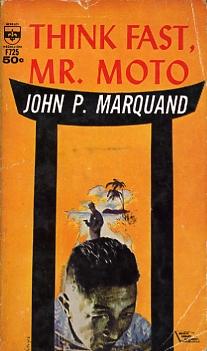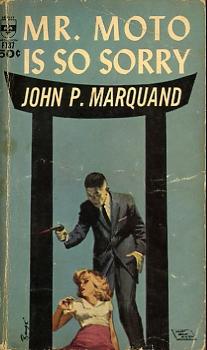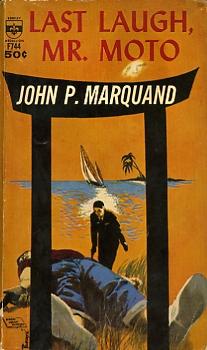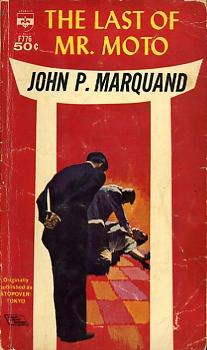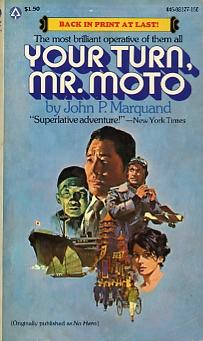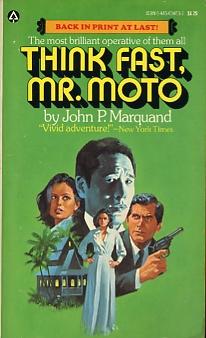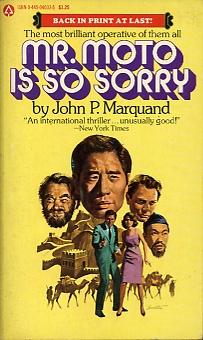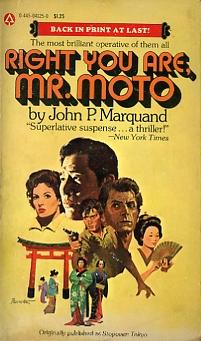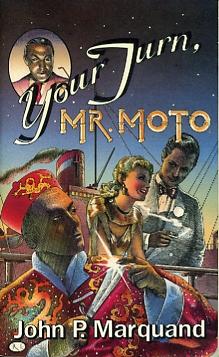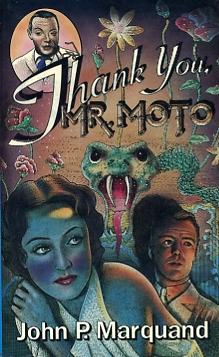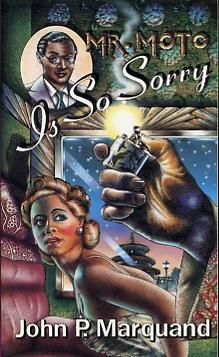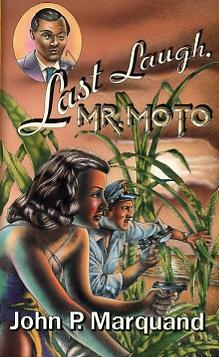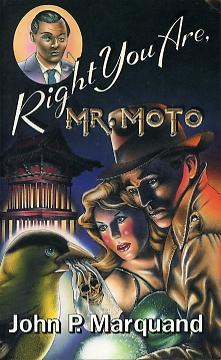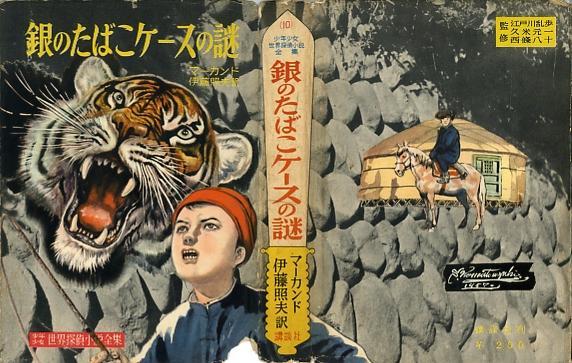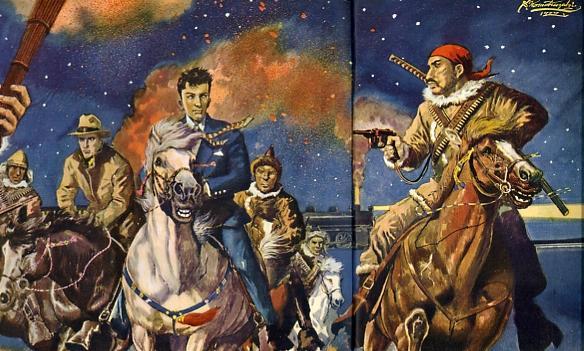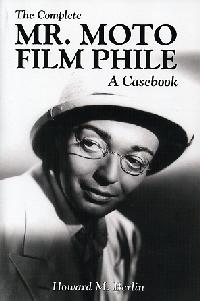The Steamy East
Steamy East heroes, heroines, and villains
By William Wetherall
First posted circa 2005
Last updated 26 July 2024
Heroes, heroines, and villains in Steamy East fiction Who's the good guy or good girl can be deceptive
Heroes, heroines, and villains in Steamy East fiction
Who's the good guy or good girl can be deceptive
This page features basic information and some commentary about the more famous Steamy East heroes, heroines, and villains -- solos who, as of this writing, are "he" men or "she" women -- or as twosomes in any combination thereof. Some villains, too, are on the list. No discrimination here.
Information will include (1) profiles of characters and (2) data about the novels and movies that have featured them. At times I have included links to the author's official website, or to non-commercial 3rd-party websites with more information about the author. I have also include, here reviews of books about he author. Links to Steamy East reviews of the author's stories are found on the Reviews page, which is essentially an index to the reviews on this websites.
Links and searches
The main Heroes page is fully viewable in this window. You can jump to any character by clicking on the name on the menu, or scroll or search for keywords (Ctrl F) within this window.
Clicking on any link to another page, whether within Steamy East or on another Yosha Bunko or other website, will replace this page in your browser. Use the "Return" key to return to this page.
| Solos |
|
Steamy East "Solos" are heroes, heroines, and villains who, though they may work with partners, assistants, or others, are mostly remembered as single characters. Their personalities, though, are not necessarily singular. Lives of their ownAll fictional characters are as real as their human begetors and some have more impact on society. Most people who have heard the name Charlie Chan probably would not recognize the name Earl Derr Biggers. Even if Biggers had been a Hemingway, Charlie Chan would be more important as an icon of popular culture and object of social criticism. Charlie Chan's staying power is remarkable. Though no longer the household word he became through films in the years before television, he is still alive and well as an archetype for a certain kind of American "Oriental" that some critics would like to see retire to the archieves. Yet his longevity continues to be extended as some emulate him while others, including a few of his dissentors, parody him in fiction if not on stage and in film. Multiple personalitiesWhile most fictional characters have only one life of their own, some -- like Charlie Chan -- have several, in the sense that their personalities change depending on who is portraying them in print or on film. Characters appearing in works that span several decades, whether or not by more than one writer, are particularly to develop in ways that reflect changes in the political and social background of the times. (WW) |
|
Mas Arai amateur detective
Created by Naomi Hirahara |
|
Several writers, from John Marquand (1893-1960) and Nan Hamilton, to E.V. Cunningham (1914-2003) and Dale Furutani (b1946), have created sleuths of putatively Japanese racial descent, of American or Japanese nationality. Most recently, Naomi Hirahara (b1962) has brought us a series of stories featuring the once-upon-a-time (if not still) dual-national Mas Arai, an Easy Rawlins pretender. Mas Arai novels2004 Summer of the Big Bachi 2005 Gasa-Gasa Girl 2006 Snakeskin Shamisen Forthcoming |
|
Burns Bannion private-eye Rick Shaw private-eye Created by Earl Norman |
|||||||||||||||||||||||||||||||||||||||||
|
Burns Bannion follows Bugs Bunny in a long list of distinguished characters with alliterative names -- like Bobby Benson, Charlie Chan, Donald Duck, Daisy Duck, Marilyn Monroe, Masao Masuto, Mickey Mouse, Mr. Moto, Red Rider, Road Runner, Sam Spade -- and not to forget William Wetherall. Bannion, the hero of Earl Norman's "Kill Me" series, is an American who stayed on in Japan after mustering out of the army during the Allied Occupation to learn karate. Mistaken one day for a private eye from California, he became one. The "Kill Me" series was originally published in New York in Berkley Books, Berkley Diamond, and Berkley Medallion editions. Norman later published them in Tokyo as "The Earl Norman Thrill Books" under his own imprint, Erle Books. The series includes the following nine titles. Kill Me in Tokyo Kill Me in Shimbashi Kill Me in Yokohama Kill Me in Shinjuku Kill Me in Yoshiwara Kill Me in Atami Kill Me on the Ginza Kill Me in Yokosuka (1966) Kill Me in Roppongi (1967) "Kill Me" in late 1950sFirst "Kill Me" titles
|
|||||||||||||||||||||||||||||||||||||||||
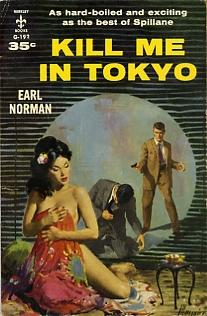
G-192 |
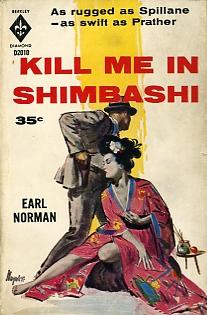
D2010 |
Seven other titles |
"Kill Me" in early 1960sFirst "Kill Me" series
|
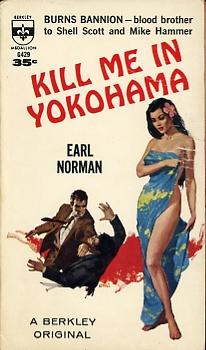
G429 |
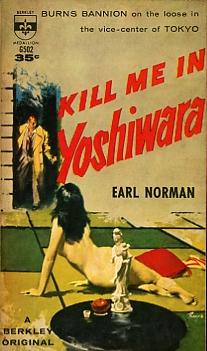
G502 |
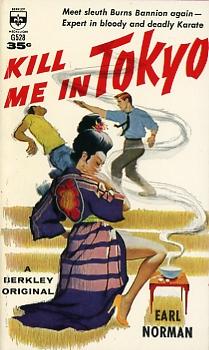
G528 |
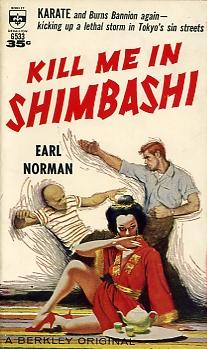
G533 |
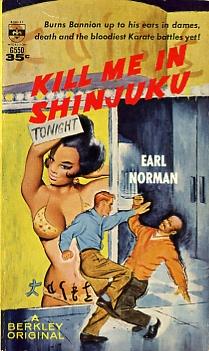
G550 |
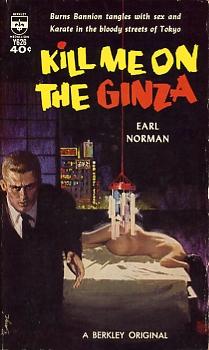
Y626 |
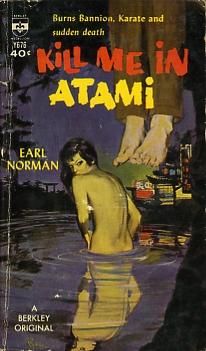
Y676 |
Kill Me in Yokosuka |
Kill Me in Roppongi |
"Kill Me" in late 1960sSecond "Kill Me" series
|
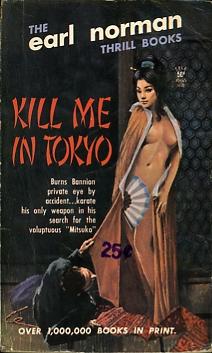
A700 |
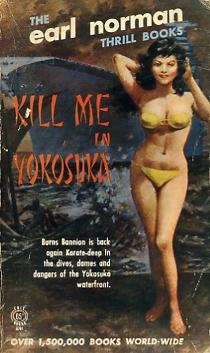
A701 |
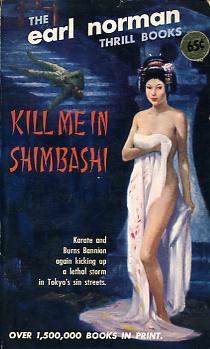
A702 |
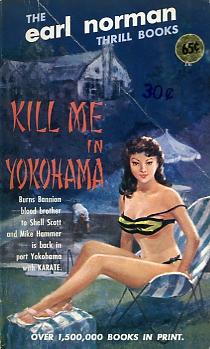
A703 |
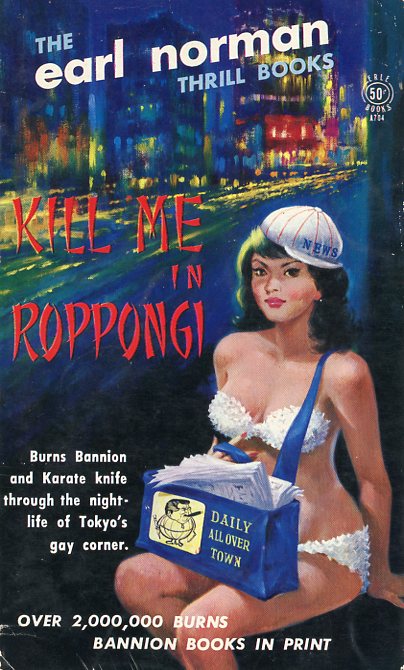
A704 |
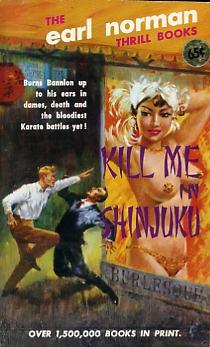
A705 |
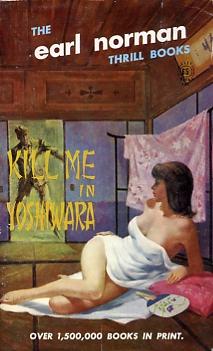
A706 |
Kill Me in Ginza (1962) |
Kill Me in Atami (1962) |
"Kill Me" in MexicoSpanish "Kill Me" series
|
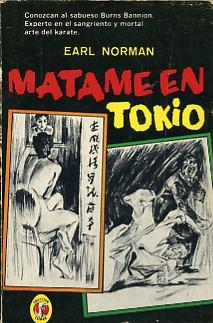
Tokio |

Yoshiwara |
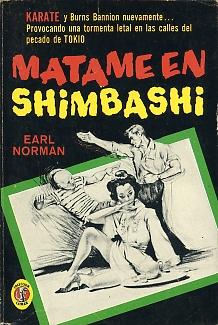
Shimbahi |
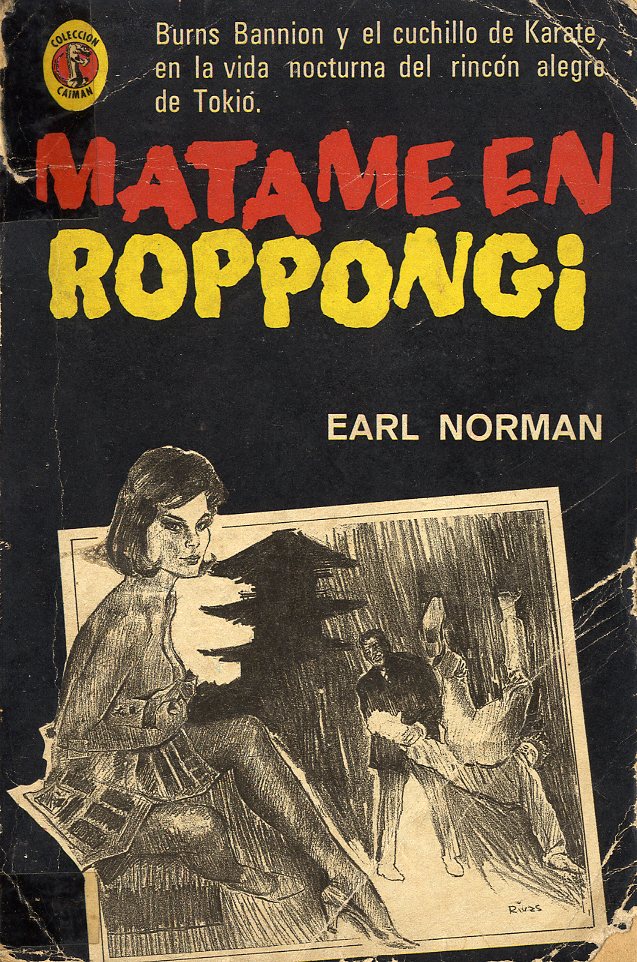
Roppongi |
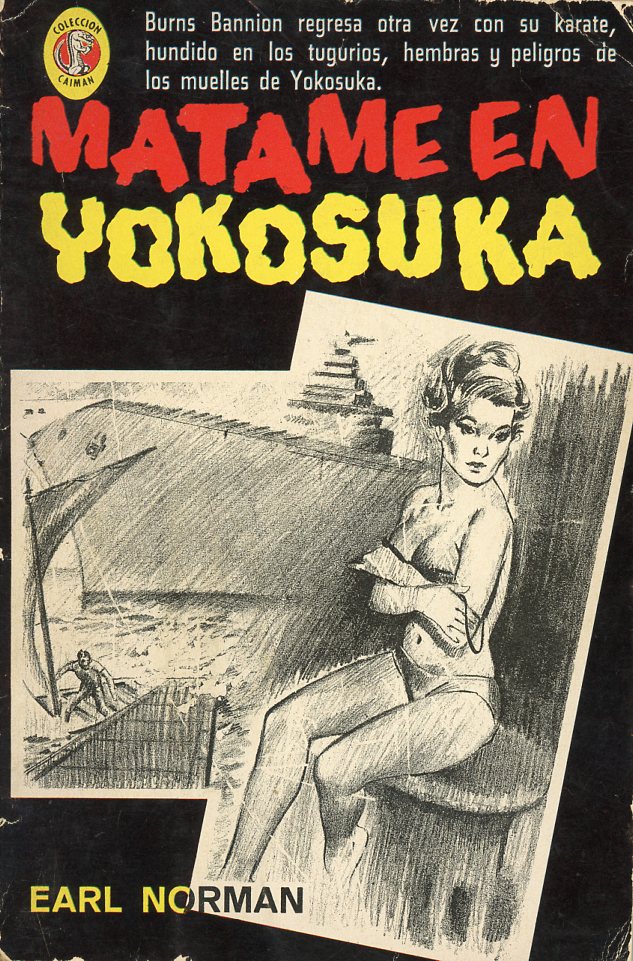
Yokosuka |
Later "Kill Me" storiesFeaturing Rick ShawTongues in certain cheeks, it seemed, were saying that Norman Thomson (Earl Norman) also created another series of action stories featuring Rick Shaw as their hero. According to Corky Alexander (1928-2002), the titles in this other series were Hang Me in Hong Kong, Bang Me in Bangkok, Maul Me in Malaysia, and Club Me in Cambodia. "Hey, Norm," Alexander wrote, "good job you never got Rick to Fukuoka!" At the time I read this, in the 3 March 2000 issue of Tokyo Weekender, I had never heard or seen a title in the alleged Rick Shaw series. So I took Alexander's remarks to be a work of humorous imagination. See the entry on Earl Norman in the the "Authors" section I later found another reference to what for me was a phantom "Kill Me" title. The Burns Bannion [dead link] "Bannionite" page on Kevin Burton Smith's "The Thrilling Detective" website, which contains information related to detectives in fiction, radio, tv, comics, and everywhere else, listed Kill Me in Hong Kong (1976). But again, I had never seen this title. Hang Me in Hong KongThen on 21 June 2008, I received an email from John Apostolou, co-editor of The Best Japanese Science Fiction Stories (Barricade Books, 1997), who kindly sent me the text and image from a 2003 auction offering of a copy of Hang Me in Hong Kong signed by Earl Norman. See Earl Norman in the Authors section for details. So at last I had evidence of at least one of the phantom titles. And in 2019 I found a very nice copy of Hang Me in Hong Kong -- inscribed by Earl Norman (1915-2000), no less, to the Tokyoite and journalist Bill Hersey (1930-2018), who probably met Norman through Alexander. The inscription was dated January 1978, so the copy had been in Bill Hersey's library since then, and presumably until his death in 2018 -- soon after which his library was put on the market -- and I just happened to spot the copy. Earl Norman |
||||||||
"Kill Me" in the futureForthcoming "Kill Me" series by Kamiyama Books
Earl Norman, visiting Tokyo during a recent o-bon festival, welcomed by the bonfire at the front gate of his biggest fan in Setagaya ward, stumbled across a setting for a new story. Through his agent on this side of the stream in Chiba prefecture, who wishes to remain anonymous, Norman has promised a tenth volume in the "Kill Me" series, but being a ghost, he needs the fan in Setagaya ward to do the leg work and even ghost write it. Kill Me in Kabukicho will pair Burns Bannion with Mark Schreiber, author of Tokyo Confidential and Tabloid Tokyo, guides to all things Japanese, copies of which Norman smuggled through the Pearly Gates. Fate compels the daring duo to defend the denizens of Japan's metropolis and ultimately the entire world -- against a rapidly growing group of e-phone cultists, whose headquarters is between a soapland and a love hotel, in the heart of Kabukichō, the Steamy East's most notorious entertainment district! Bannion and Schreiber have only three days -- before Bannion has to return to his life in the Yellow Springs -- to save the world from the menace of the e-phone cult -- which recruits new members from the ranks of nursery school, kindergarten, and elementary school teachers -- who give their charges free e-phones with which to open secret accounts on the cult's server, play inspirational cult games, and exchange messages with other young and old cult members. |
|
Vincent "Vinny" Calvino Private-eye
Created by Christopher G. Moore |
|
Forthcoming. |
|
Charlie Chan Chang "Ah Ping" Apana (1871-1933)
Created by Earl Derr Biggers |
Charlie Chan's rootsCharlie Chan was inspired by the real-life Detective Chang Apana (1871-1933), who joined the Honolulu Police Department in 1898 and fought crime on Oahu until he retired in 1932. He died the following and is buried at Manoa Chinese Cemetery. Apana is said to be an Hawaiianized version of Chang's dimunitive Chinese name, Ah Ping. Earl Derr Biggers (1884-1933) read about Chang's exploits while vacationing in Hawaii in 1919, and wrote six Charlie Chan novels between 1925 and 1932. He also died in 1933, the same year Chang Apana passed on. Charlie Chan debuted as a Detective-Sergeant in the Honolulu Police Department. By the last novel he had been promoted to Inspector. Charlie Chan todayCharlie Chan is kept alive today partly by DVD producers who market Hollywood mustiness, and partly by professors of racial stereotyping who wish Chan had never been born but make their living telling their students why. See Charlie Chan will never die and related articles and reviews. Charlie Chan censorshipFrank Chin loves to spoof Charlie Chan. His takeoffs on Chan go back to his own takeoff as a dramatist and novelist. "Confessions of a Number One Son"The cover story on the March 1973 issue of Ramparts is "Charlie Chan in America / Confessions of a Number One Son" by Frank Chin (Vol. 11, No. 9, pages 41-48). The author profile remarks that Chin wrote The Chickencoop Chinaman, which had played in New York the near before, and names a couple of literary awards he had won for his fiction. The last line states "He is at work on a novel "Charlie Chan on Maui" under contract with Harper & Row" (page 41). "Confessions of a Number One Son" is a fictional story in which Chin pokes serious fun, in his now trademark biting humor, at the images of Chinese in Hollywood films. The story begins like this (page 41). I was born and last seen being carried off by allycats into a dark neighborhood. William Bendix found me in the rubble of a village during a Japanese air raid at my dead momma's withered tit wailing hoarsely. The movie was China. I was the symbol of helpless, struggling China in the arms of William Bendix. He named me "Donald Duck." The wail went from movie to movie. The Japs have tortured me into giving up the secret position and are driving the little life of me left in my little battered body in a truck full of Jap soldiers out to get the jump on John Wayne and my missionary teacher from Indiana and all my friends. . . . Chin thus takes the reader on a veritable tour of how Chinese, Japanese, and Asian Americans have been cast in Hollywood films over the decades. There is, in fact, a Donald Duck in China (1943), played by Irene Tso, who also played Wu Lien's Third Child in Dragon Seed (1944). Both are wartime films which feature China and Chinese as allies of the United States. The tagline of China is "Alan Ladd and twenty girls -- trapped by the rapacious Japs!" Donald Duck's dying dream is that Keye Luke, Victor Sen Yung, Benson Fong, Richard Loo and other such actors, who played bit parts in early Hollywood films, "will find themselves in a movie, dying without a scene and end up like me, seen fit only as a fanatically faithful Chinese-Catholic convert, cooking and dusting for Humphrey Bogart passing himself off as a priest, at an out-of-the-way Chinese village on the road of life" (page 48). In a scene with a beautiful woman horny for Bogart, Bogart said I took care of him, "like a good wife." Whatever it was I'd done, Hollywood hadn't forgiven me or forgotten. I stood in the middle of the movies out of the seating section and asked the stars, why I had to die and why they had to make me smile when Bogart likened me to a woman in front of a beautiful woman. I try to talk them out of leaving me alone to die. I'll die, but why do I have to be alone? If I could only be out of the room when Bogart likens me to a woman, or if I didn't understand English in this movie. And the people in the audience wait for Spencer Tracy and the airmen to leave me behind, see it becoming inevitable and weep for me, and they wait for the woman to knock on Bogart's door and come in and laugh. "Charlie Chan on Maui" This is Frank Chin warming up for later stories, including his novel Donald Duk )1991), published nearly twenty years later. But it was in Gunga Din Highway (1994) that Chin got developed his theme of the successor of Charlie Chan in Hollywood. For Charlie Chan on Maui was never published. Chin finished his novel but it was never published. If memory serves me, the folks who owned the "Charlie Chan" trademark said Chin couldn't use the name for his character. The owners were determined to keep Chin's ax from biting into their Charlie Chan money tree. Charlie Chan on Maui survives in manuscript, though. At least one copy can be found among the The Ishmael Reed Papers in the Special Collections Department of The University of Delaware Library. The poet and novelist Ishmael Reed (b1938) gave the university his papers, spanning 1964-1995 and running some 65 linear feet. Part IV, Editing and Publishing, 1965-1992, contains the following items. Chin, Frank, Charlie Chan On Maui F253 Part I These items are grouped with others under the heading "Unsolicited submissions" -- suggesting that Chin sent a draft of Charlie Chan on Maui to Reed for his comments. Chin and ReedFrom 1967, when ethnic studies movements were heating up the campus, Reed began teaching at the University of California at Berkeley and living in Oakland. Reed was on Frank Chin's turf, and the two writers got to know each other. Reed was one of the founding publishers of the Yardbird Reader series. Reed dedicated Volume 3 (Berkeley: Yardbird Publishing, 1974) to Asian American writers. It was guest-edited by Shawn Wong and Frank Chin. The back cover of Yardbird Reader, Volume 3 shows a photograph of Wong and Chin with Jeffery Paul Chan and Lawson Fusao Inada, the other two members of the quartet who edited Aiiieeeee! the same year. The dustjacket of Aiiieeeee! has a similar photo from the same shoot. Both pictures are classic studies of four young men at the thresholds of their various careers as writers, teachers, and activists. Reed and Chin also share the view that some popular novels by minority female writers have put down minority men. Just as Chan has faulted the works of writers like Maxine Hong Kingston and Amy Tan for putting down Chinese and Chinese American men, Reed has criticized Alice Walker's The Color Purple and Steven Spielberg's film version of the novel for negatively portraying black men. NAATA protests 1981 Chan filmA number of Asian American advocacy organizations have attempted to suppress the showing of vintage and even new films they consider unfit for public consumption because of Asian stereotypes. One such organization is the Center for Asian American Media (CAAM), whose primary mission is to facilitate education about Asian American experiences through film and public television. CAAM receives funding from the Corporation for Public Broadcasting (CPB) and several major foundations. CAAM was founded in 1980 as the National Asian American Telecommunications Association (NAATA). NAATA fought the release in 1981 of the retro comedic mystery film Charlie Chan and the Curse of the Dragon Queen, which starred Peter Ustinov as Charlie Chan and Angie Dickinson as the Dragon Queen. "Charlie Chan and the Curse of the Dragon Queen" bombsThomas Godfrey, in "Charlie Chan For Rent" (The Armchair Detective, Vol. 22, No. 4, Fall 1989, pages 352-364), made this observation about the fate of Charlie Chan and the Curse of the Dragon Queen (page 358). San Francisco activists were vehement in their protests, disrupting the filming, then picketing the openings. They denounced the racial misrepresentations and demanded a Chinese-American actor be given the chance to play Chan. They probably felt vindicated when they saw the results. The script was amateurish, the direction jokey, and the acting an embarrassment. Curse was a miserable dud. Fox cancels 2003 Chan film festivalWhile NAATA failed to stop Charlie Chan and the Curse of the Dragon Queen, or its tie-in novel, twenty years later, in 2003, it succeeded in persuading Fox Media Channel to cancel a Charlie Chan summer film festival. Howard Berlin, author of two Charlie Chan film books and a study of Mr. Moto films, wrote the following lament, dated August 2003 and still posted on his website under the title Anti-Charlie Chan Hysteria. June 27 [2003] will be the day remembered by movie fans when Fox Movie Channel (FMC) bowed to special interest pressure and pulled the plug on their highly publicized, Summer-long showing of 20 Charlie Chan films (restored and remastered) and one Mr. Moto film. [ omitted ] I feel that FMC has taken a hypocritical position in bowing to pressure from Asian groups who point to only the few negative aspects of perhaps the most popular series of Hollywood's golden age, but condone many of the stereotypes that are staples in many of today's Kung Fu-like movies. The real gripe here is that the older Chan movies had a non-Asian actor in the lead role and ignores that the movies highlight the positive side of Chinese culture, much of which the rest of the world could profit from. [ omitted ] Unlike other parts of Rupert Murdoch's Fox network family, FMC is neither fair nor balanced. Fox Movie Channel spent a lot of money in the restoration of the Chan films and with the cancellation of the series, it now seems that FMC now has assets that will be of no future commercial value to them. If FMC truly feels that these films have negative stereotypes in today's politically correct climate, then FMC should immediately seek out a buyer for these films and the copyrights that go with them. Otherwise keeping them from an appreciative viewing audience is Indeed censorship. NAATA's chargesThe "The Charlie Chan Mystery Tour" was slated to run on Fox Movie Channel each Monday night in June, July and August. I get the impression that the first film or two was shown, and this prompted NAATA to protest. NAATA's then executive director Eddie Wong reportedly wrote a letter in which he called Chan "a hoary stereotype that has dogged Asian Americans for decades" and insisted that he was "one of the most offensive Asian caricatures of America's cinematic past." Apparently Wong, who grew up in Los Angeles in the 1950s, also wrote that "Charlie Chan's shuffling, subservient manner and exaggerated accent and fortune-cookie chatter did not resemble my parents, friends or any Chinese person I knew," and that "By running the Chan movies, the Fox Movie Channel (is) reviving hurtful stereotypes instead of helping our society move toward harmony." Fans reactBlogs and forums were suddenly alive with charges of mindless political correctness by Charlie Chan fans, who made the point that it is hypocritical of Asian American organizations to condemn the essentially positive caricature of Charlie Chan but accept kung fu films simply because they feature, or are produced by, Asians. Tim Lucas, the driving force behind the monthly magazine Video Watchdog and related websites, lamented that FMC had "caved in" and made this astute observation, according to Marc Morano (Fox Movie Channel Bans Charlie Chan Movies, CNSNews.com, 1 July 2003). If the Charlie Chan films continue to be branded unfit entertainment, where does that leave a film like D.W. Griffith's Broken Blossoms (with Richard Barthelmess as a Chinese man), or Luise Rainer's Oscar-winning performance in The Good Earth, or Spielberg's Indiana Jones films, which actually demonize its Eastern and German characters in the manner of a '40s pulp magazine? Or is it acceptable to portray an Asian as the Devil incarnate as long as a real Asian or Asian-American is playing the role? Fox Movie Channel statementOn 27 June, Fox Movie Channel reportedly made the following statement on its website, at a URL that no longer exists [www.thefoxmoviechannel.com/chan_pop.html]. Fox Movie Channel will discontinue the broadcast of the Charlie Chan mystery films. Originally restored to meet the requests of mystery fans and film preservation buffs, Fox Movie Channel scheduled these films in a showcase intended to illustrate the positive aspects of these movies such as the complex story lines/ characters and Charlie Chan's great intellect. Additionally, numerous subscribers to Fox Movie Channel, as well as film historians, have long requested that Fox Movie Channel broadcast these films. However, Fox Movie Channel has been made aware that the Charlie Chan films may contain situations or depictions that are sensitive to some viewers. Fox Movie Channel realizes that these historic films were produced at a time where racial sensitivities were not as they are today. As a result of the public response to the airing of these films, Fox Movie Channel will remove them from the schedule. In the hope that this action [cancellation] will evoke discussion about the progress made in our modern, multicultural society, we invite you to please click CONTACT US to send us your thoughts on the matter. Fans still waitingOnly about a dozen Charlie Chan films are currently available on DVD through Amazon.com. Fox Video has has released four of the earlier Fox (pre Twentieth-Century Fox) Chan films with Warner Oland, and the Spanish version of the lost Charlie Chan Carries On film. MGM Home Entertainment has released six of the Monogram Pictures films with Sidney Toler in DVD. Many Charlie Chan fan sites encourage visitors to urge Twentieth Century Fox Home Entertainment to release its remastered Twentieth-Century Fox Chan films on DVD. In 1989, Key Video, a CBS/FOX archive company, brought out seven Twentieth-Century Fox Chan films -- three with Oland, four with Toler -- in a VHS "Charlie Chan Collection". "Again," according to Thomas Godfrey, "Chinese-American protests were heard. But Fox went ahead" (ibid., page 359). The VHS releases of these Fox films were repackaged in 1998. Fox brought out some of these titles on DVD in 2006 in what it called "Volume 1" of its Charlie Chan Collection. By 1998, MGM had also released six of its Chan films in VHS, and in 2004 the same six films came out in collection called "Chanology". Charlie Chan novelsFive writers have produced a total of 12 Charlie Chan novels. Earl Derr Biggers1925 House Without a Key 1926 The Chinese Parrot 1928 Behind the Curtain 1929 The Black Camel 1930 Charlie Chan Carries On 1932 Keeper of the Keys Dennis Lynds (Michael Collins)Dennis Lynds novelized a screenplay written by Ed Spielman and Howard Friedlander for the made-for-tv movie The Return of Charlie Chan, also known as Happiness is a Warm Clue, starring Ross Martin as Charlie Chan. The movie was produced in 1971 but not shown on NBC until 1979. Though the film hadn't been shown, the novel was sandwiched between the first three and last three of the original six novels in Bantam Books 1974-1975 paperback series. 1974 Charlie Chan Returns (No. 4 in a series of 7) Robert Hart DavisFour Charlie Chan novellas were published under the name "Robert Hart Davis" in the short-lived Charlie Chan Mystery Magazine, a quarterly published by Renown Books in Los Angeles in only one volume of four issues from November 1973 to August 1974. 1973-11 CCMM 1-1 Walk Softly, Strangler 1974-02 CCMM 1-2 The Silent Corpse 1974-05 CCMM 1-3 The Temple of the Golden Horde (Collins) 1974-08 CCMM 1-4 The Pawns of Death (Pronzini, Wallmann) "Robert Hart Davis" was a house name shared by Michael Collins, and by Bill Pronzini and Jeffrey M. Wallmann as a team, and two of the novellas have since been published under their actual names. Bill Pronzini, Jeffrey M. Wallmann, Earl Derr Biggers Charlie Chan in the Pawns of Death New York: Wildside Press, 2002, hardcover New York: Borgo Press, 2003, paperback 108 pages Michael Collins Charlie Chan in the Temple of the Golden Horde New York: Wildside Press, 2003, hardcover New York: Borgo Press, 2003, paperback 128 pages Michael Avallone1981 Charlie Chan and the Curse of the Dragon Queen Tie-in with 1981 America Cinema Production Charlie Chan and the Curse of the Dragon Queen With Peter Ustinov as the indomitable Charlie Chan and Angie Dickinson as the Dragon Queen Charlie Chan moviesAll of the first five stories were made into movies. The sixth and last, Keeper of the Keys, was made into a Broadway play the year Biggers died in 1933. Bigger's infinitely patient, aphorism-spouting sleuth inspired a total of 47 films, radio and television dramas, comic strips and comic books, and several namesakes, like "Chan" in the "Hsu and Chan Tanaka" duo. The image of Charlie Chan that came to dominate book covers and comics was created by white actors in yellowface, particlary Warner Oland (1879-1938), who was born Johan Verner Olund in Sweden, and did not migrate to the United States until he was thirteen. Oland first played Charlie Chan in the 1931 Fox production of Charlie Chan Carries On and made a total of sixteen Charlie Chan films between 1931 and 1938. Sidney Toler (1874-1947) took over for Oland and made a total of twenty-two Charlie Chan movies, eleven for Fox (1938-1942) and eleven more for Monogram Pictures (1944-1947). Toler was succeeded by Roland Winters (1904-1989), who starred in the last six of the 42 vintage Charlie Chan films (1947-1949). Peter Ustinov also played Charlie Chan in yellowface in the 1981 retro comedic mystery Charlie Chan and the Curse of the Dragon Queen. However, the first three Charlie Chan films featured three Asian actors as the Chinese detective from Hawaii. 1926 The House Without a Key Pathe silent film George Kuwa (1885-1931) played Charlie Chan. Kuwa was born in and also passed away in Japan. 1926 The Chinese Parrot Universal silent film Kamiyama Sojin (1884-1954) played Charlied Chan. Kamiyama was born in Sendai and also died in Japan. He was active in the United States from 1919 to 1929, where he appeared mostly in silent films as Sojin. He played the blind Biwa hoshi in Seven Samurai. 1929 Behind That Curtain Fox talking film E.L. Park, born in Korea, played Charlie Chan. While it may be good news that two Japanese actors and one Korean actor were cast as the Chinese American detective Charlie Chan -- the bad news is that, though all three films were based on the novels from which they took their titles, Charlie Chan's role was reduced to that of a minor character. Charlie Chan linksThere are many Charlie Chan fan sites on the Internet. Most are concerned with the nearly fifty Charlie Chan films that have been made, which are marketed in DVD "Chanthologies" and shown, when the censors aren't looking, on television. CharlieChan.netCharlie Chan is one of the larger sites for fans of the now classic Charlie Chan films. The splash page begins with this teaser. Just how much work Charlie Chan actually got done for his employer, the Honolulu Police Department, is open to conjecture, since he was seemingly always on the road-- "in Rio," "in Panama," "at Treasure Island," "in Paris"-- you get the picture. A "Charlie Chan Poll" asks "Who was the best Charlie Chan?" The choices are Warner Oland, Sidney Toler, and Roland Winters. No Peter Ustinov and no Longman Kwan -- you get the picture. Charlie Chan FamilyThe Charlie Chan Family is another fan site that focuses mostly on DVD releases of Charlie Chan films. It also has links to numerous other Chan sites -- featuring everything from chronologies and biographical profiles, to trailers of Charlie Chan movies, panels from Charlie Chan comic books, and audio libraries of Charlie Chan radio programs Series GalleryUnfortunately few websites feature much information on the Charlie Chan novels. One exception is the Series Gallery within the Newport Vintage Books site. Selecting Charlie Chan on the "Mysteries" list will yield details on publications and images of covers. Fu Manchu, Mr. Moto, and Sumuru are also listed but not as fully developed. |
|
Chen Cao Inspector Chen
Created by Qiu Xiaolong |
|
Forthcoming. |
|
Judge Dee Di Renjie / Ti Jen-chieh (630-700)
Created by Robert van Gulik |
|
Forthcoming. |
|
Fu Manchu
Created by Sax Rohmer |
|
|
The Page of Fu Manchu The Page of Fu Manchu is full of information and links related to Sax Rohmer's Fu Manchu. According to its own blurb: The Page of Fu Manchu represents an ongoing effort by scholars and readers around the world to create a definitive Sax Rohmer bibliography, reference and archive. It is edited and maintained by Dr. Lawrence Knapp, an English Professor at Essex County College and Thomas Edison State College. The Associate Editor is Dr. R. E. Briney, a Professor of Computer Science at Salem State College in Massachusetts. Dr. Briney was the editor of Sax Rohmer's biography as well as fourteen issues of The Rohmer Review.
Jenny Clegg You read the blurbs on the back cover first because they tell you about how a book is pitched. Chinese people are often portrayed in media and films as a closed, mysterious community, master-minded behind the scenes by cruel gangsters and drug barons. This book confounds these stereotypes and exposes the systematic nature of racist ideology through a critical analysis of the myth of the 'Yellow Peril', epitomised by the character of Fu Manchu, the stereotypical Oriental master-villain popularized in the fiction and film of the 1920s. The myth is contrasted with the lives of the Chinese communities in Britain, and the contextualised historical relations between Britain and China. The persistence of the underlying themes and images in popular culture has implications for the present-day Chinese in Britain and this book should be read by all those concerned to develop antiracism in education and in the wider community. Thoroughly confounded, I turned to the Preface. The aim of this book is to investigate the systematic nature of racist ideology through a critical analysis of the myth of the 'yellow peril', epitomised by the character of Dr. Fu Manchu, the stereotypical mysterious, threatening and unknowable Oriental master-villain. . . . The Preface, like the blurb on the back, speaks of "the Chinese in Britain" and concludes that "the real concerns of the Chinese in Britain today can neither be appreciated nor responded to . . . until the roots of the 'yellow peril' myth are fully exposed." The book has four chapters. Chapter 1: Fu Manchu: the 'Yellow Peril' incarnate Chapter 2: Of Opium and 'Coolies': Sino-British relations in the 19th Century Chapter 3: Race Riots and Revolution: relations between the British and Chinese in the early 20th century Chapter 4: The Chinese in Britain today: media images and real lives The impression that this book was designed for use as a supplementary reader in a classroom is confirmed by its thinness, the Learning Objectives at the beginning, the Worksheet at the end of each chapter and Consolidated Worksheet at the very end, and the boxed citations of stereotypical passages from novels and other print media. This book is typical of materials designed for the education market in "multi-racial Britain" in that it deepens the very racism it claims to want to expose. It does so by speaking of "the Chinese communities in Britain" and "the Chinese community in our midst" as though "members of Chinese communities in Britain" could not possibly be British. (WW) |
|
Inspector Ghote Bombay Police
Created by H.R.F. Keating |
|
Bombay/Mumbai police inspector Ganesh Ghote is the protagonist of twenty-six novels and anthologies.
1. 1965 The Perfect Murder
2. 1966 Inspector Ghote's Good Crusade
3. 1968 Inspector Ghote Caught in Meshes
4. 1968 Inspector Ghote Hunts the Peacock
5. 1969 Inspector Ghote Plays a Joker
6. 1970 Inspector Ghote Breaks an Egg
7. 1971 Inspector Ghote Goes by Train
8. 1972 Inspector Ghote Trusts the Heart
9. 1974 Bats Fly Up for Inspector Ghote
10. 1976 Filmi, Filmi, Inspector Ghote
11. 1979 Inspector Ghote Draws a Line
12. 1980 The Murder of the Maharajah
13. 1981 Go West, Inspector Ghote
14. 1984 The Sheriff of Bombay
15. 1986 Under a Monsoon Cloud
16. 1987 The Body in the Billiard Room
17. 1988 Dead on Time
18. 1989 Inspector Ghote, His Life and Crimes
(Short Stories)
19. 1990 The Iciest Sin
20. 1991 Inspector Ghote and Some Others
21. 1992 Cheating Death
22. 1994 Doing Wrong
23. 1996 Asking Questions
24. 1996 The Inspector Ghote Mysteries (An Omnibus)
25. 1999 Bribery, Corruption Also
26. 2000 Breaking and Entering
The title The Perfect Murder is a play on the family name of the Parsi murder victim. The novel won Keating a Crime Writers' Association Gold Dagger Award and a nomination for an Edgar Award. Better not to have been thereKeating wrote the first nine Ghote stories before his first visit to the country -- and having been there he found it more difficult to write (Meera Tamaya, H.R.F. Keating: Post-Colonial Detection (A Critical Study, 1993, page 23). When Keating visited India ten years after he first started writing about it . . . he did so with trepidation. Yet his imaginative grasp of India was so real and so accurate that the usual things which discombobulate foreigners -- the beggars, the lepers, the heat -- did not faze him. And yet the details of Indian life made such an impact on him that when he started a short story, he found he was filling pages with observed minutiae, and he could not get to the story. He observes echoing the oet Keats' paean to the imagination: "I saw the error of my new way, and I hope afterwards did not allow myself to be dragged down by sticky facts from the real world instead of being buoyed up by airy ones passed through the transfiguration factory of the imagionation". Keating's lack of in-country experience seems to have been a blessing (page 11). Keating, studying India assiduously from a safe distance, seems to have a more accurate grasp of these intricacies than those who, confronted with India over a brief but intense span of time, are so overwhelmed by the impact India makes on them, that they fail to notice the myriad distinctions. In other words, Keating's imaginative grasp of India did him better service than the actual experience of living in the country did to many western writers. This phenomenon is not unlike Shakespeare's imaginative understanding of an Egyptian Queen. He did not have to be a woman or an Egyptian to present a complex, vivid, believable portrait of Cleopatra. Tamaya (see review) insists it is not her intent to rank Keating with Shakespeare. She mearly wishes to stress "what the poet Keats understood so well: imagination is the dream of truth" (page 11). Ghote's appealGhote is attractive as a character because he is unpretentious and lacks a clear physically image (Page 5). Inspector Ghote of the Bombay police is the very antithesis of [detectives like Sherlock Holmes, who look on their world with a sense of irony, a privilege of the aristocrat who is above the vulgar scramble for mere survival]. He is a hopelessly bedeviled professional, hamstrung by the mysterious ways of the Indian bureaucracy, bullied by his boss and nagged by his wife. Far from being brilliant, Ghote solves crimes more by dogged persistence and flashes of intuition than by superior rationation. Also, unlike Holmes with his equiline nose and his pipe, Poirot with his pointed waxed moustaches, Ghote has no distinguishing physical features. He remains a physically shadowy figure. [Keating: occasionally refers to his thin bony shoulders. We are given no other details. It is hard to visualize him and he is treated by his colleagues and superior as a mere cog in the creaky machinerey of the Bombay police force. Keating's last Ghote novel came out in 2000. The same year, and practically every year since, he has brought out a novel in a series featuring Detective Chief Inspector Harriet Martens, a protagonist he seems to have created especially for the 21st century. |
|
Superintendent Kiet Bamsan Kiet, Hickorn Police
Created by Gary Alexander |
|
Bamsan Kiet is the Superintendent of Police of the mythical Southeast Asian country of Luong. His assistant, Captain Binh, is American trained. Kiet and Binh are teamed in six novels and a number of short stories. Superintendent of Police Bamsan Kiet mysteriesThe first three Bamsan Kiet novels originated as short stories in Alfred Hitchcock Mystery Magazine (AHMM). Walker and Company brought out the first two, and St. Martin's Press published the last four. Alexander kept Bamsan and Binh going in AHMM for nearly a decade after the novels stopped coming out. The Golden Peacock, June 1986 (AHMM) Pigeon Blood, February 1987 (AHMM) Kiet and the Inflationary Gap, July 1987 (AHMM) 1. Pigeon Blood, 1988 (Walker and Company) 2. Unfunny Money, 1989 (Walker and Company) 3. Kiet and the Golden Peacock, 1989 (St. Martin's Press) 4. Kiet and the Opium War, 1990 (St. Martin's Press) 5. Deadly Drought, 1991 (St. Martin's Press) 6. Kiet Goes West, 1992 (St. Martin's Press) Kiet and the Custodians, May 1992 (AHMM) Kiet and the Raids, September 1997 (AHMM, ss) Kiet and the Drive-By, October 1998 (AHMM, ss) Kiet: One Day in the Life of, March 1999 (AHMM) Captain Binh and the Bidji, May 2001 (AHMM) See Six Superintendent Bamsan Kiet novels for more. |
|
Masao Masuto
Created by E.V. Cunningham |
|
Masao Masuto is a Beverly Hills PD nisei detective created by EV Cunningham, a pen name of Howard Fast (1914-2003), father of the fantasy fiction writer Jonathan Fast (b1948). One blurb describes Masuto as "a cultured stranger in an even stranger land of traffic-clogged freeways, artery-clogging fast food, and brutal murders." Masuo Masuto is the hero of seven novels. 1. 1967 Samantha 2. 1977 The Case of the One-Penny Orange 3. 1978 The Case of the Russian Diplomat 4. 1979 The Case of the Poisoned Eclairs 5. 1981 The Case of the Sliding Pool 6. 1982 The Case of the Kidnapped Angel 7. 1984 The Case of the Murdered Mackenzie The comparatively thin stories are being re-issued in double-feature volumes.
2000 Masao Masuto Investigates
Samantha and One-Penny Orange
2003 The Hollywood Murders
Sliding Pool and Kidnapped Angel
|
|
Mr. Moto I.A. Moto [Imperial Agent Moto]
Created by John Marquand |
|||||||||||||||||||||||||||||||||||||||||||||||||||||||
|
John P. Marquand (1893-1960) wrote six Mr. Moto novels -- five before Pearl Harbor, and one after the war. The fifth story was serialized in Collier's as Mercator Island from September through October 1941 and came out in hardcover as Last Laugh, Mr. Moto in 1942.
1. 1935 No Hero (serialization and book in US)
Saturday Evening Post, 30 March to 4 May 1935
1935 Mr. Moto Takes a Hand (British title)
1963 Your Turn, Mr. Moto (Berkley Medallion)
1988 Mikado no Misutaa Moto
[The Micado's Mister Moto]
Japanese translation serialized in EQMM
2. 1936 Thank You, Mr. Moto (serialization and book)
3. 1936, 1937 Think Fast, Mr. Moto (serialization, book)
4. 1938 Mr. Moto Is So Sorry (serialization and book)
1939 Moko no gyoran
[Dawn storm over Mongolia]
Japanese translation by Mizutani Hiroshi
Mister Moto renamed Muto-shi
1957 Gin no tabako keesu no nazo
[Mystery of the silver cigarette case]
Japanese translation by Ito Teruo (Tsuzuki Michio)
1977 Tenno no mittei (Misutaa Moto no boken)
[The emperor's secret agent
(The adventurers of Mister Moto)]
Japanese translation by Shinjo Tetsuo
Reissued in paperback in 1981
5. 1941 Mercator Island (serialization)
1942 Last Laugh, Mr. Moto (book)
6. 1956-1957 Rendezvous in Tokyo (serialization)
1957 Stop Over Tokyo (book)
1963 The Last of Mr. Moto (Berkley Medallion)
1977 Right You Are, Mr. Moto (Popular Library)
For another introduction to Mr. Moto novels and a bibliography, see The Mr. Moto novels of John P. Marquand website created by James S. Koga, a science reference and instruction librarian at California State Polytechnic University (Cal Poly) in Pamona, California.
|
|
Sam Ohara
Created by Nan Hamilton |
|
Japanese American police lieutenant Sam Ohara was created by Nan Hamilton in The Shape of Fear (1986). Ohara inspired the 13 episodes of the ABC series "Ohara" (1987-1988). Lieutenant Ohara was played by the comedian and actor Noriyuki "Pat" Morita (1932-2005), better known for his role as the sensei in The Karate Kid cycle (1984, 1986, 1989, 1994). |
|
John Rain Junichi Fujiwara
Created by Barry Eisler |
|
John Rain, aka Junichi Fujiwara, is what you might get if you were to ask Chat GTP to come up with an international agent-at-large, assassin-for-hire, and martial arts master -- in the skin of a yellow-Japanese white-American mixed-blood Vietnam vet. He's the best in his line of work, and though he's not large or fierce-looking, but you'd better not be in his line of sight. Eisler calls him "half-Japanese, half-American" or "Japanese American". There are speakers of English for whom "Japanese Americans" or "Japanese-Americans" means mixed blood, and for some speakers of Japanese, words like "Nikkeijin" (日系人), "Beikoku-kei Nihonjin" (米国系日本人), and "Nisei" (二世) conger up images of people with both foreign and Japanese blood.
1. 2003 Rain Fall
> A Clean Kill in Tokyo
2. 2003 A Lonely Resurrection
3. 2004 Winner Take All
4. 2005 Redemption Games
5. 2006 Extremis
6. 2007 Requiem for an Assassin
> The Killer Ascendant
7. 2011 The Detachment
8. 2014 Graveyard of Memories
9. 2017 Zero Sum
10. 2019 The Killer Collective
11. 2021 The Chaos Kind
To be continued. |
|
Tetsuo Otani
Created by James Melville |
|
Superintendent Otani, of the Hyogo Prefectural Police in Kobe, was created by James Melville while Melville, as Peter Martin in real life, was representing the British Council in Tokyo. |
|
Inspector Saito
Created by Janwillem van de Wetering |
|
A Japanese detective created by Janwillem van de Wetering, a Dutch writer who also created Amsterdam policemen Adjutant Grijpstra and Sergeant De Gier. |
|
Mark Shigata Small-town Texas police chief
Created by Anne Wingate |
|
What does a former police officer with a PhD in English do? Write crime fiction and crime-fiction guidebooks, of course. One of Wingate's series features Mark Shigata, first as an FBI agent, then as a police chief and sheriff of Bayport, Texas. Mark Shigata novels1. 1988 Death by Deception 2. 1989 The Eye of Anna 3. 1991 The Buzzards Must Also Be Fed 4. 1992 Exception to Murder 5. 1993 Yakuza, Go Home! Writer's guidesAnne Wingate has also authored or coauthored guides for writers of detective and crime fiction Anne Wingate, Ph D. Elaine Raco Chase and Anne Wingate |
|
Rei Shimura amateur sleuth
Created by Sujata Massey |
|
Rei Shimura, created by Sujata Massey, lives in Japan, where she is an antique dealer, an occupation which seems to carry a high risk of getting involved in crime. "Rei" as Massey calls her hero has appeared in nine novels since 1997. The novels have been published in Australia, Bulgaria, Finland, Germany, India, Japan, the Netherlands, Norway, Poland, Russia, and Thailand, in addition to the United States. Many facesMassey has posted the covers of some of these editions, to show what various cover artists think Rei looks like. Her own comments on Rei's many faces (website): The pictures are pretty interesting, I think, and offer a window into the way the different countries regard mixed heritage people. For example, while the U.S. and European covers usually feature a model who looks 100% Asian, the heroine on the Japanese versions looks almost totally Caucasian! I've especially enjoyed the manga-themed covers that were designed by publishers in Germany and Finland. See Massey's website for more. |
|
Sugawara no Akitada born 985
Created by I.J. Parker |
|
Sugiwara no Akitada is a minor bureacrat in the Ministry of Justice of 11th-century Japan. A fictional character created by I.J. Parker, Akitada was born into the Sugawara family of scholar officials, the only son of a father who served as a minor functionary in the administration of the imperial court in Heiankyo, now Kyoto. In Parker's words (her website): Akitada pursued a legal curriculum and placed first in the final examinations. This guaranteed him a position in the government service, and he started his career as a very junior clerk in the Ministry of Law. By this time, his father had died, leaving him the only support for a demanding mother and two younger sisters, a responsibility he will have increasing difficulty with by getting involved in criminal cases that are none of his business and lead to reprimands and even dismissals (see "Akitada's First Case"). "Akitada's First Case" (AHMM, July/August1999) won the Private Eye Writers of America Shamus Award for Best P.I. Short Story in 2000. It is the fourth of over ten Akitada short stories Parker has had published in Alfred Hitchcock's Mystery Magazine. What's in a nameWhile the Sugawara clan was, in history, a family of scholar officials, Sugawara no Akitada is Parker's creation. There was, actual history, a court noble named Fujiwara no Akitada (898-965), who served as Minister of the Right (Udaijin), the third highest court rank, from 960 until his death in 965 twenty years before Sugawara no Akitada was born in Parker's fiction. As the Fujiwara were much higher in status and more powerful than the Sugawara, the real Akitada would probably take exception to being reincarnated as a mere Sugawara. The Minister of the Right oversaw the ministries of Military Affairs (Hyobusho), Justice (Gyobusho), the Treasury (Okurasho), and the Imperial (Kunaisho). In this sense, too, Akitada in real life was demoted in the world of fiction. See Parker's website for more. |
|
Virgil Tibbs
Created by John Ball |
|
Forthcoming. |
|
Zhong Fong
Created by David Rotenberg |
|
Forthcoming. |
| Twosomes |
|
"Twosomes" are Steamy East heroes and/or heroines who come in pairs. Most recent partnerships involve a man and a woman -- police, private, and amateur detectives, and medical examiners -- who team up to solve not only heinous crimes but also the boy-girl mysteries. Sexual and racial rivalryWhile it is possible to treat Fu Manchu as a solo character, despite the repeat appearances of several accomplices, his relentless pursuers -- Nayland Smith of Scotland Yard and his friend Dr. Petrie, reminiscent of Sherlock Holmes and Dr. Watson -- are inseparable. Though male twosomes consisting of a principle (often a social mainstreamer) and a sidekick (often a social minority) are still found in fiction and film and on tv, the emergence of women in workplaces once dominated by men has inspired a vertiable menagerie of male-female teams in more egalitarian and usually romantic relationships. The racial meat marketThe longstanding preference for partners of different social status continues, but now the combinations are more likely to mix race and sex in ways that are clearly contrived to appeal to current interests in interracial, interethnic, and international romance. Miscegenation, once a taboo, or very sensationally when not delicately treated in fiction, is now de rigueur. It is also, for the most part, contrived for the multiculturalist marketplace -- and therefore boring. Wong / Lomax transformationsMany of the twosomes that meet at the crossroads of race and sex in Steamy East fiction today are basically socially-liberated transformations of Suzie Wong and Robert Lomax. Instead of meeting each other in the real-enough bars of Oriental porttowns or the fabulous tunnels of Occidental Chinatowns, they hook up at police departments in Beijing or New York -- or, like Jessica and Ki, they look out for each other on a Texas ranch in the days of the wild west. The spice shelf of the Steamy East now includes African American, Latin American, and a number of other flavorings for readers who are ready for more than the usual Oriental / Occidental seasoning. (WW) |
|
David Brazil and Marva Chang
Created by Jack L. Chalker |
|
Jack Laurence Chalker (1944-2005) -- who partly rests in his family plot, in several waterways, and on H.P. Lovecraft's grave -- is best known for his Well of Souls series and Well Watchers trilogy. Both Well World sagas feature a number of common characters, but most notably David Brazil and Marva Chang. David Brazil and Marva Chang, if not exactly a couple or even partners, are always double trouble for their common enemies in and about the Well World -- where there are few humans or even former humans, and some species are able to change other species into anything they want. The Well World, an artificial planet, is inhabited by thousands of immigrant species which live in their own environmentally specific hexes. The efforts of a Well World government to regulate inter-hex affairs and keep peace among the species is not very successful. Any spaceship what gets too near the Well World is likely to be drawn into it. Crashing or landing on its surface makes escape all but impossible. The environment of each hex is optimized for its inhabitant species and may be hostile to other species, which in any case may not be welcome. Alien species undergo some degree of transformation, to assimilate them to the Well World or enslave them within a hex. Chalker's Wonderland Gambit trilogy -- The Cybernetic Walrus (1995), The March Hare Network (1996), The Hot-Wired Dodo (1997) -- also involve supercomputer-mediated changing of species, gender, body shapes, intelligence, cultural and sexual behavior, and switching of bodies or body parts in a manner that some critics find reminiscent of Buddhist jataka reincarnation stories. If Chalker had fans who raved at his parodies of human life, he also had detractors who found his plots and gimmicks too often repeated and chaotic, and even commonplace in a genre overrun with transformations. It seems to me, though, he was mainly out to have fun, and didn't lose sleep worrying about the boundaries between sci fi, fantasy, cyperpunk, and old-fashioned adventure, which he straddled with abandon. The Well of Souls series1. Midnight at the Well of Souls, 1977 2. Exiles at the Well of Souls, 1978 3. Quest for the Well of Souls, 1978 4. The Return of Nathan Brazil, 1980 5. Twilight at the Well of Souls, 1980 6. The Sea is Full of Stars, 1999 7. Ghost of the Well of Souls, 2000 The Watchers at the Well trilogy1. Echoes of the Well of Souls, 1993 2. Shadow of the Well of Souls, 1994 3. Gods of the Well of Souls, 1994 See Nathan Brazil and Marva Chang: Human remnants at the Well of Souls for more. |
|
Jessica and Ki
Created by Wesley Ellis |
|
Forthcoming. |
|
Li Yan and Margaret Campbel
Created by Peter May |
|
"I wanted to reverse the stereotypical thing of the little Chinese woman and the macho American guy," May has said in an interview. Now, in Chicago forensic pathologist Margaret Campbell and Beijing detective Li Yan, we have a thriller facsimile of a liberated yet cautious American female medical examiner, and an equally cautious Chinese investigator who doubles as her lover. So far, six titles have appeared in the series.
1. The Firemaker, 1999 Prior to starting what he calls "The China Thrillers", May published at two hardcover thrillers, Hidden Faces in 1981 (US Title: The Man With No Faces), and The Noble path in 1992. Oddly, there have been no US editions of the series -- until 2005, when St. Martin's Minotaur brought out a hardcover edition of The Firemaker. May made a promotional tour of a number of book stores, suitably dressed in a kilt, and left behind stacks of signed copies for readers to snap up. |
|
Liu Hulan and David Stark
Created by Lisa See |
|
Forthcoming. See See's website for more. |
|
Ivan Monk and Jill Kodama
Created by Gary Phillips |
|
They come as streetsmart as private investigator Ivan Monk and his lady, Superior Court Judge Jill Kodama. They manage to spend time together despite their busy careers that sometimes clash on the crime-ridden streets of Los Angeles. The narrator of Violent Spring, the first in several Monk mysteries, calls Monk and his secretary as "black" by page two. Forty pages later Kodama is described as a "Japanese-American woman". Ivan Monk mysteriesNot all Ivan Monk mysteries feature the romance between Monk and Kodama, but the first four do. 1994 Violent Spring 1995 Perdition, U.S.A. 1998 Bad Night Is Falling 2000 Only the Wicked There is also a collection of "13 Stories from the World of Private Eye Ivan Monk" called Monkology (2004). To be continued. See Phillips' website for more. |
|
Sano Ichiro and Reiko Yoriki (senior police commander)
Created by Laura Joh Rowland |
|
"Yoriki Sano Ichiro, Edo's newest senior police commander, made his way slowly on horseback across Nihonbashi Bridge," begins chapter one of Shinju (1994), the first volume of Laura Joh Rowland's Sano Ichiro mystery series. Sano, a former tutor and history scholar, is one month into his position and already he is finding it tedious and "far less satisfying than teaching young boys and studying ancient texts." We have already been told that the setting and time are "Edo, Genroku Period, Year 1, Month 12". Rowland has explained in parenthesis that is means "Tokyo, January 1689". This is only half correct. The lunar calendar date is roughly January 1689. But Edo does not become Tokyo until mid 1868. But you get the idea. Rowland is trying to be authentic without being too boorish. Most Honorable InvestigatorThe shogun's sosakan-sama -- "Most Honorable Investigator of Events, Situations, and People" -- deals with "ritual double suicides" in more than one story. This is Rowland's conventional English tag for "shinju" -- which was neither "ritual" nor necessarily "double" suicide. Sano endeavors to follow "Bushido" as he contends with assassins, outcastes, ninja mystics, spies, bodies of Dutch traders, kidnappers, prostitutes -- and the corrupt and villainous Chamberlain Yanagisawa, among other enemies in the shogun's government. Enter Lady ReikoBy the fourth novel, The Concubine's Tattoo (1998), Sano has been married to the willful Lady Reiko, who would rather help him solve his mysteries than just serve him as a wife. Well, someone's got to uphold the standards of late 20th-century American women in late 17th-century Japan. From the fifth novel, The Samurai's Wife (2000), the series features the samurai detective Sano and his wife Lady Reiko as a twosome. By the sixth novel, Black Lotus (2001), they have a son. Reiko to the rescueIn another story Reiko -- who just happens to be young and beautiful -- is abducted with a pregnant friend who's name is Midori. Rowland probably found both names in a Genroku edition of How to name your Japanese baby. Reiko looks out for wrongly accused women. In Black Lotus (2001) she is not convinced that a "teenaged girl" who has been charged with a crime is innocent. In The Assassin's Touch (2005) she comes to the defense of an outcaste woman who has been accused of murder -- and a fingerprint links the murder to a case in Sano's lap. Costumed escapeThe object of a costume drama is to draw the mind into another place and time. It really doesn't matter whether the costumes and props are authentic. All that matters is the illusion that they are. One reviewer seems to think that Sano is an earlier incarnation of more recently fictional investigators. "Sano may carry a sword and wear a kimono, but you'll immediately recognize him as an ancestor of Philip Marlowe or Sam Spade." (Denver Post) Rowland is especially proud that Sano has been placed in the family tree of such fictional greats. The above remark is first listed among the plugs printed in some of her books -- and it is the only praise she features front and center on the opening page of her website. Rowland herself has partly attributed her motivation to write mysteries to her "heritage". By this she means that her father "loved Agatha Christie, Erle Stanley Gardner, Mickey Spillane, Ross McDonald, and other great, classic detective writers" -- and she considers herself "a real chip off the old block" (website). See Rowland's website for more. |
|
Bill Smith and Lydia Chin
Created by S.J. Rozan |
|
Bill Smith and Lydia Chin are private investigators in New York who sometimes collaborate on cases. S.J. Rozan came up with the character of Bill Smith first, and says this about how Lydia Chin came into the picture (Rozan's website). So Smith's sidekick needed to be a woman because he's a man, small because he's big, young because he's middle-aged, athletic because he's an intellectual?and then I thought, hell, why not go for the whole nine yards (a construction expression, by the way) and make her someone from a different ethnic group so that everything he thinks he knows is up for grabs. Asked why "Chinese" and if she's "part Chinese" (as though this should make any difference), Rozan said this (website). Not any part. But I'd always been interested in China, I've always had Chinese friends -- the Chinese have never seemed "exotic" to me, their culture hasn't ever seemed "impenetrable" or, god help us, "inscrutable." It's always seemed like an interesting culture and history, one that can be studied and learned about just like mine (Eastern European Jewish) or anyone else's. So I studied, and I hope I've learned. "China" and "Chinese" more exoticSo Rozan sets out, from the start, to treat Lydia Chin as an "ethnic" or "cultural" entity -- because she's interested in "China" and has had "Chinese" friends. And she maximizes Chin's usefulness as a foil for her interests by making her the American-born daughter of Chinese immigrants who live in New York's Chinatown. This allows Rozan to write about Chin's extended Chinese family, Chinatown, and even China. When Rozan began developing her characters, she discovered that Chin was as strong a character as Smith. She decided to give them equal time, by alternating the narrative voice between them. So one moment the reader sees the world through Smith's eyes, the next through Chin's. On balance, however, Chin is the stronger character. Rozan shows much less interest in Smith as an "ethnicity" or "culture" or even sexual entity -- because ultimately she is moved to write by personal interests in "China" and "Chinese" -- and, I would say, women who are clever enough to keep a fish on a line without landing him. Endless unrequited loveSmith has developed romantic interests in Chin, and while she is not entirely repelled by him, they don't get involved sexually like Li and Campbell, Liu and Stark, and Woo and Sanchez. Rozan has even won a anti-Edgar "Hauled Ashes Award" for "the fictional couple most in need of getting it on" (website). So the big question is -- will they? In one interview Rozan says "Do I know? I'm only the writer" (website). In another she says only "In Bill's dreams" (website). See Rozan's website for more. |
|
Nayland Smith and Dr. Petrie
Created by Sax Rohmer |
|
Forthcoming. |
|
Inspector Wang Anzhuang and Rosina Lin
Created by Christopher West |
|
Wang Anzhuang is a somewhat old-fashioned yet unorthodox detective in the Beijing Central Investigations Department of the Public Security Bureau. Mostly he goes about solving his crimes by himself, but Rosina Lin, his citified and more up-to-date girlfriend who became his wife, always in the background of his mind, sometimes joins him in the foreground of the drama. The Wang series unfolds without the usual involvement of a non-Chinese alter ego. 1. Death of a Blue Lantern, 1994 2. Death on Black Dragon River, 1995 3. Death of a Red Mandarin, 1997 4. The Third Messiah, 2000 |
|
April Woo and Mike Sanchez NYPD police officers
Created by Leslie Glass |
|
Leslie Glass makes it clear who's boss in her novels featuring NYPD detective April Woo and precinct captain Mike Sanchez. Mike may out rank April in the larger scheme of departmental politics, but April is on top of everything, including Mike when she feels the need -- though Glass wisely leaves the steamier details of their romantic relationship to the reader's imagination. Otherwise, Woo and Sanchez are pretty much off-the-shelf "ethnic" characters. April WooApril Woo "in the minority both as a woman and an Asian in all the precinct detective squads where she has worked" (website). But she is "bright and strong" and is destined for police stardom In other ways, too, April a essentially a multiculturalist and feminist morph of what, in earlier Steamy East fiction, would have been just a "China doll" type (website) NYPD Detective Sergeant April Woo is a slender young woman with delicate features who defies the typical image of a cop, although she knows how to use the 9 mm she's packing. Mike SanchezMike Sanchez is typical of cops who come with "as much internal baggage as they do weapons and clanking cop equipment" (website). He is also an archetypal "Mexican American" cop (website). Mike is a complicated man with strong character and deeply ingrained street smarts. He has his scars and sorrows, but he is no angry burnout. He was one of those street kids who could easily have gotten sucked up in the gangs and never lived to see his twentieth birthday. As an adolescent, he was tough, he was a fighter, and he got in trouble. April and Mike's parentsThe April Woo novels are full of episodes about how April Woo's family worry about both her prolonged singleness, and her interest in the likes of Mike Sanchez. parents, siblings, and extended family worry ab Leslie Glass is obviously interested in food and festive fun, in addition to law enforcement, cultural diversity, and psychology. April Woo's father, Ja Fa Woo, happens to be a "Number One chef in Midtown on the East Side". He wants to celebrate April's 31st birthday with a big Chinese dinner, but her "Skinny Dragon Mother" Sai Yuan Woo was ashamed of a "worm daughter" who had not yet married. Both parents agree they don't want "to advertise April's Spanish ghost boyfriend to the Woo's [sic] two hundred closest friends and relatives at one of the most expensive restaurants in town" (website). Mike's father had been a chef at a restaurant he partly owned until his death five years earlier. Unlike April's parents, though, Mike's mother, Maria Sanchez, "had no qualms about advertising April to her friends -- even though April was too skinny and not a Catholic." So Maria throws a "Mexican Fiesta Birthday Dinner" for April at the restaurant, and the Woos attend (website). Dr. Jason FrankIf April Woo and Mike Shanchez reflect Glass's "passions for law enforcement, the diversity of American culture, and the Asian-American experience", the psychiatrist Dr. Jason Frank expresses her interest in "people's motivations for their actions, and the effect therapy has on their lives". She created Frank "to show how a psychiatrist would approach suspects, and crime, as a counterpoint to the law enforcement strategies used by the police" (website). Where Glass's novels "vibrate with chilling psychological suspense" will depend on whether your vibrator is charged with as much interest in gender and ethnic relations as hers is. See Glass's website for more. |
